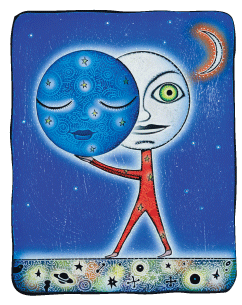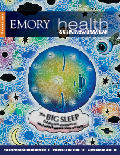The big sleep
by Robin Tricoles, illustrations by Joel Nakamura
Emory sleep experts are exploring questions and finding answers to what really happens when we sleep.
Search for alarm clocks on the Internet, and the results will yield a startling array of choices: clocks that ring, chime, and hum. Clocks that glow, shout (a tiny drill sergeant), and fly. Yes, fly. That is, you must get out of bed to squelch its incessant sound. You must cease to sleep.
But what does it mean to sleep? How do we define it? And what happens to our brains when we do so? Apparently, a lot. But we know only a fraction of what this is.
On the surface, it looks as if there’s nothing to it, but actually sleeping is an exquisitely complex process. In humans, sleep involves a series of precise physiologic and chemical transitions that transport us from wakefulness to sleep and back again.
“We spend a third of our lives sleeping, and I don’t think anybody knows why,” says Emory neurologist and scientist David Rye. “Sure, there are the pat answers: neurochemical regeneration and such, but at the end of the day, I don’t think we really know why we sleep even though every organism does it. I mean even worms have rest cycles.”
So do flies. “We’re doing some things here on campus with Drosophila,” says Rye. “You can’t record sleep in flies per se, but you can observe their rest cycles. We know that if we don’t let the fly rest, we’re going to see an increase in rebound rest, rest that makes up for a deficit.” Just like in sleep-deprived humans.
What the stages tell us
Researchers study relatively simple organisms, such as worms and flies, to understand the molecular machinations behind sleep—or the lack of sleep, especially in humans.
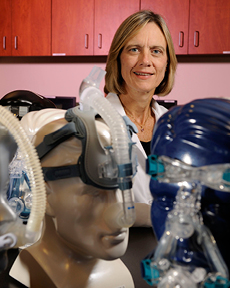
Emory Sleep Center Director Nancy Collop, shown here with sleep aids for sleep apnea, studies the disorder in hospital patients. |
“It’s hard to keep humans awake for more than 72 hours,” says Emory pulmonologist Nancy Collop, who directs the Emory Sleep Center. “Even at 48 hours with no sleep, people tend to have microsleeps, very brief bursts of sleep that intrude on wakefulness.” When experts measure brainwaves during microsleeps, the waves look more like sleep than they do like wakefulness. Even when the eyes are open during microsleep, the person is blind because the visual parts of the brain close down.
“Your brain is not one big blob,” Collop says. “In fact, several distinct parts of the brain interact to get us into the sleep state. There are all sorts of interesting things about the transition from wake to sleep.”
One of those interesting things involves the sleep cycle itself, which includes four stages: stages one through three, plus rapid eye movement (REM) sleep. However, the stages do not take place necessarily in that order. Instead, sleep begins in stage one and progresses orderly through the next stages until REM sleep is over, when it returns to stage two. Neurotransmitters, such as serotonin, norepinephrine, and adenosine, govern largely whether we’re awake or asleep.
During stage one, muscle activity slows, and we drift in and out of sleep and can be awakened easily. During stage two, eye movement stops and brain waves slow with intermittent bursts of fast waves, known as sleep spindles. By stage three, very slow brain waves, or delta waves begin, punctuated by small, fast waves and eventually leading to a predominance of delta waves. REM sleep includes eye movement, increased respiration rate, and brain activity, including dreaming.
Although scientists don’t know exactly why, these stages are critical to a good night’s sleep. Evidence of their importance rests in the difference between the sleep state and the comatose state. Although a coma may resemble sleep to observers, the brain waves tell a different story.
The EEG of a person in a coma typically shows the slowest of the slow brain waves—the deltas, according to Emory neurologist Lynn Marie Trotti. While some slow waves appear during sleep, particularly in stage three, “during comas, it’s all slow wave all the time,” says Trotti. “Presumably it’s not restorative in the same way as sleep.”
What’s more, the same factors that drive sleep aren’t driving comas. With sleep, the drivers are circadian rhythm and sleep pressure; that is, the longer one is awake, the more one needs to sleep. But a coma is unattached to those drivers—with one exception. If someone is in a persistent vegetative state, they sometimes show hints of day-night cycling, Trotti says.
A walk on the wild side
Because the brain has so many parts involved in sleep, things can sometimes go awry. One such malfunction involves a dissociation among the parts of the brain that coordinate sleep: that is, some parts are acting as if the body is awake while others act as if it’s asleep. The result: parasomnias, such as sleepwalking and sleeptalking.
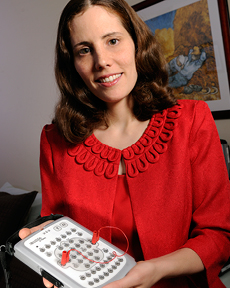
Emory neurologist Lynn Marie Trotti holds a jack box, where researchers plug in the electrodes used in a sleep study. Trotti explores parasomnias, such as sleepwalking and sleeptalking, to understand how the parts of the brain interact during sleep. |
“Sometimes there are abnormal parts of the sleep-wake transition where people do wake-like activities when they’re asleep,” says Collop. “It happens because key parts of the brain are not inactive as they should be in normal sleep. So you can have some motor activity. You can walk. You can talk. You can supposedly drive a car.”
Although parasomnias are not yet well understood, they are well documented. “For example, the body should move very little when higher cortical levels are dampening themselves down,” says Trotti. “But with parasomnias, you’re able to walk when you still don’t have conscious awareness of what’s around you.”
As it turns out, the more common types of dissociations that lead to parasomnia occur during non-REM sleep, the deeper, slow-wave phase of the sleep cycle. More common in children, non-REM parasomnias often are related to neurodevelopment. While clinically we think of them as disorders, they are so common that some researchers believe they may just be a manifestation of normal brain development. Very young children may experience sleep terrors, whereas older children may experience sleepwalking. However, most children outgrow these parasomnias.
The rarer forms—and the potentially dangerous kinds of parasomnias—occur during REM sleep. These forms are strikingly different and manifest differently from more common parasomnias. In non-REM parasomnia, a person essentially gets stuck in a transition between deep sleep and being awake. It can be brought about by one of two scenarios, says Trotti. In the first, a person has a condition such as sleep apnea that causes frequent waking. Because the person is waking so often, she is more likely to get stuck in this transitional state. In the second case, the person has an abnormally deep sleep that is harder to wake from, so, again, she is more likely to get stuck. Sleep deprivation is one cause of abnormally deep sleep.
“It’s thought that when you finally do sleep, it’s so deep that it triggers parasomnias,” she says.
In REM parasomnia, the brain has bypassed muscle atonia—in essence paralyzed muscles—allowing people to act out their dreams and creating a potentially dicey situation. “The normal sleep state is not to move a muscle during REM sleep,” says Trotti. “If someone experiencing REM can still move freely and act out the dream, it’s very dangerous.”
In rare cases, people may be causing problems right in their own bedrooms. “For reasons we don’t understand, with REM behavior disorder, the dreams are usually violent,” says Trotti. “And what’s more, they are defensive violence. For example, you may dream that someone is attacking you, and you respond to it. That’s when people strangle their spouse, break things, and punch and kick.”
People with this disorder often don’t think of it as an illness. “You have to ask patients,” Trotti says. “They won’t necessarily volunteer that they gave their spouse a black eye last night. People with REM behavior disorder are sometimes assumed to have some deep, underlying psychiatric illness or some repressed motivation for the violence. But they don’t.”
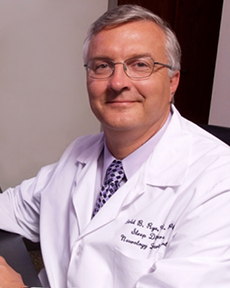
Emory neurologist David Rye, an expert on restless legs syndrome, is testing a treatment for hypersomnias (see sidebar below). |
Instead, parasomnias such as sleepwalking and REM sleep disorder tend to run in families. So does restless legs syndrome (RLS). RLS is a common neurologic disorder, characterized by a compelling urge to move the legs, most often accompanied by an unpleasant sensation, which is difficult for patients to describe. It occurs most often before or during sleep. Rye, who with an international team of researchers was the first to identify a gene associated with the disorder, knows firsthand about RLS. He has it, and so does his wife.
“Restless legs is a symptomatic trait,” says Rye. “It’s genetic. Nature loads the gun. Then something happens that triggers it. It could be neuropathy. It could be spinal cord injury. It could be liver or renal failure. The gene is very common. So people are walking around, ready to have restless legs.”
In fact, 10% of the U.S population and about 1% of school-aged children have RLS. A major cause of insomnia and sleep disruption, it has been linked to hypertension. “When you kick, your blood pressure goes up by about 30 mm,” says Rye.
One can be kicking and not know it, which occurs more often in middle-aged men than in middle-aged women, says Rye. Women are more often aware of the sensation, although men kick more.
Measuring up
Interestingly, gender differences in sleep aren’t limited to middle-aged men and women with RLS—babies also display such differences. To appreciate that notion, stop for a moment and consider what any parent can tell you: babies grow when they sleep.
Emory’s Michelle Lampl, a biological anthropologist, recently finished the first study of its kind that measures the link between daily growth and sleep in infants. Her study showed that sleep and growth are inextricably linked. “Science is finally confirming what grandma knew all along: infants wake up taller right after they sleep,” says Lampl.
“Specifically, growth spurts are tied to an increase in total daily hours of sleep as well as an increase in the number of daily naps,” she says. “Longer naps predict an increase in weight and body fat composition tied to an increase in length. But exactly how this happens is not known.”
As far as gender differences go when it comes to sleep, Lampl’s study found that growth spurts in babies are associated with increased lengths of naps in boys and an increased number of naps in girls.
The hours
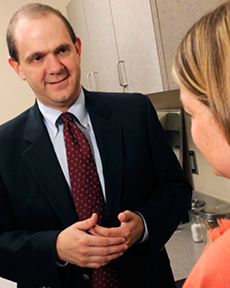
Emory pulmonologist David Schulman studies the causes and effects of sleeplessness, which he equates to drunkenness. |
Unlike babies, many adults are uninclined or unable to nap and get too little sleep. That’s not good because sleeplessness, says Emory pulmonologist David Schulman, is akin to drunkenness. “If you’re an alcoholic, you may think you’re fine to drive, but you’re not. And the same is true for those who are chronically fatigued. People who are chronically fatigued suffer from the misconception that they are performing optimally, but they are not.”
Many studies of medical residents have likened driving home post-call to driving drunk. In fact, one study of residents in a simulated driving task showed that residents driving post-call performed worse than drunk people who were not post-call.
How sleepy we are at any one moment depends on many things: when we woke up, how many carbohydrates we just ate, what medications we take, how much sleep we got the night before. But more and more researchers are starting to look at how sleepy we are as a genetic trait.
In studies on twins, in which researchers ask how much of variance in sleep is explained by genetics as opposed to sleep apnea, medication, RLS, or some other condition, 50% to 80% of the variance is explained by genetic relationships. Genetics explain approximately half of cases of insomnia as well. “The biggest factor by far is what genes you were born with,” Rye says.
However, both genetic and environmental causes may contribute to narcolepsy. Narcolepsy causes profound daytime sleepiness, even marked muscle weakness, sometimes in the middle of routine activities such as talking or eating.
Some people affected by narcolepsy have too little hypocretin, a neurochemical closely linked to wakefulness. But what causes low levels of hypocretin isn’t well understood. Researchers believe that several factors—including heredity, infections, brain injuries, and autoimmune disorders—may cause deficiencies in this chemical.
Recently, Rye saw an 8-year-old boy in his clinic who had strep. Two weeks later, the child had developed narcolepsy. “When kids get sick with strep, that might be one thing that triggers narcolepsy,” Rye says. “He’ll have it the rest of his life.”
Some would argue, Rye included, that sleep is a vital sign, a barometer of our health, especially when it comes to how much we get versus how much we need. “If you look at how much we sleep, there’s a distribution,” says Rye. “If you take people at both extremes, they have higher morbidity (like inflammation and insulin resistance) and even higher mortality. So if you don’t sleep enough, that’s not good. And if you sleep too much, that’s not good either. The good stuff is right at seven, seven and a half hours. That seems to be the happy place.”
Rye and his fellow sleep researchers at Emory believe that understanding sleep is going to give us huge insights into how insulin control and breathing are regulated, how the heart functions, and how so many of our systems work. “There’s a genuine need to understand sleep,” he says.-EH
|
Web Connection: For more info, call 404-778-7777, or visit http://emoryhealthcare.org/sleep/. Videos about Emory sleep research are at bit.ly/sleephealthvideos and bit.ly/historyofsleepmed. A podcast on how sleep loss affects long-term health is bit.ly/davidschulman. |
Waking from the Deep Sleep
David Rye and colleagues on the Emory sleep team are hunting for biomarkers of hypersomnias, narcolepsy, and excessive daytime sleepiness in a new place—specifically the cerebrospinal fluid (CSF) and plasma. The researchers analyzed biomarkers in the CSF and plasma of 31 people suffering from hypersomnia—research which Rye recently presented at the 2011 international SLEEP conference. In fact, it was one patient’s presentation that prompted the team to reanalyze other samples of CSF in their files. That woman, “Anna,” was a 32-year-old attorney who first came to Emory in 2005 because of an overwhelming need for sleep—reaching at times 57 hours at a stretch. Initially, the researchers were unsure of the cause, but after extensive analysis of her CSF, they identified activity that enhanced the brain’s most abundant “shut down” chemical—namely gamma-aminobutyric acid (GABA). Emory’s sleep team next surmised that flumazenil, a drug targeted at reversing anesthesia and sedative overdoses by way of GABA, might work as a possible treatment for Anna. Over two days, they gave higher doses of flumazenil intravenously while continuously monitoring her vital signs, electroencephalogram, and performance metrics. When the dosage reached 2mgs., Anna exclaimed, “I feel alive!” She has continued to enjoy sustained improvement for three years. |
|||


